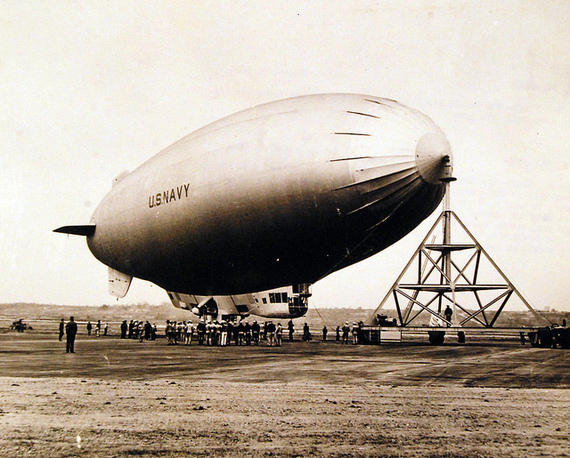The US Patent Office just awarded Amazon a patent for flying warehouses. In addition to giving it vast amounts of mobile storage space, the E-commerce leader plans to use these warehouses as launchpads for its drone delivery force. It has already branded these flying blimp-like storage facilities as Airborne Fulfillment Centers, or AFCs.
How will they operate?
Shuttles (smaller air ships) will be used to transport workers to and from the AFCs, replenish them with inventory, and provide them with necessary fuel, and supplies. The AFCs will hover at high altitudes - roughly 45,000 feet. Drones will be deployed to deliver ordered items to customers. As they descend to their destinations, the drones are expected to use little or no power.
They laughed when I predicted packages will be delivered by drones
When I first wrote a post in August of 2013 suggesting that companies will deliver products via drones, a number of readers "laughed at me" in their disparaging replies. Here is just one of the more polite ones...
"What makes you think these drones won't have cameras, and audio recorders and sniffers? What leads you to think that these tracking devices will be accurate, tamper-proof, incorruptible and honest? Will they deliver to my fourth floor walkup? My fortieth floor elevator lobby? Stinky gas driven, or nuclear? Shoot-able? How about net-able? The unemployed, more everyday after this, will grab these and sell the parts. Especially the nuclear fuel. Yeah. Can't wait."
Vindication from Jeff Bezos and Charlie Rose
Not long after my post, during a 60 Minutes broadcast, Jeff Bezos showed Charlie Rose a room full of "Octocopters" branded as Amazon Prime Air that will deliver products to customers. Bezos, Amazon, Charlie Rose and 60 Minutes have the corporate image credentials to give this idea credibility, and once the FAA issues are resolved, you will see this happen. At the time of the broadcast, Bezos said he is an optimist and predicted it will happen in 4 or 5 years. Others said it would take 15 years.
Further vindication from Walmart
In 2015, Walmart announced it has asked the FAA for permission to test drones for delivery in its parking lots and at customer homes. It also wants to use drones to check inventories and the condition of its vast network of facilities. Since there is a Walmart store within 5 miles of 70% of the US population, drones potentially provide an efficient way to move product through its extensive supply chain.
Amazon makes its first drone delivery
On December 14th of this year (2016) - just 3 years after the optimistic prediction of 4 to 5 years, Amazon already made its first successful drone delivery to a customer in the UK. I hope that the naysayers are paying attention.
Potential for being a very efficient distribution channel
As many already know, the Internet has become perhaps the most convenient channel for distributing products. Buyers can search for what they want, find products that fit their needs, compare prices, read reviews on the products and sellers, and order products 24/7 without leaving the comfort of their home or place of business.
Main drawback
The problem is that for products that are not in digital form, buyers have to wait for packages to be physically sent via common carriers or through the mail. Too often, shopping carts are abandoned once charges are shown. Currently, this is the bottleneck in the process. To overcome this bottleneck, those that want the product right away typically travel to a local store with the hope of finding it in stock. Of course, buyers still have to make their way to the store as they worry about time, traffic, parking, and other inconveniences. And, in some cases, they are disappointed to learn that the store does not have what they want.
Technologies to solve the distribution problems
In addition to Amazon's AFCs and drones, there are some interesting technologies available (and on the horizon) that might provide a solution to the problems related to physically distributing products. In particular, drones and 3-D printers hold a lot of promise in the not so distant future.
3-D printers
A technology that is here today and being rapidly advanced for delivery of products is 3-D printing. Users will be able to order products via the Internet, Smart TVs, and smart mobile devices. A 3-D printer at the ordering location (for those that have one) or at a 3-D printing center (operating similar to a FedEx copy center) will then make the products according to a blueprint, recipe, or software program. Where will the ingredients that are fed into the printer come from? There are many possibilities. They might be (1) already purchased in a traditional way and stored in the home, office, hospital or place of business, (2) loaded into purchased cartridges similar to ink cartridges in an inkjet printer, (3) delivered by drones, or (4) sent through a system of underground tubes similar to the way water, gas, and other utilities are delivered today. Taking this one step further, once products are used, a similar (but separate) tube system can be used to sterilize, recycle, and process any waste.
If you think this sounds crazy, just wait...
While this may sound far-fetched, the system of utilities, modes of transportation, and technologies that are commonplace today would be hard to imagine not so long ago. Perhaps the biggest hurdles are not technological. They are more likely political, legal, regulatory, and economic. Municipalities need the vision to invest resources in these delivery and recycling systems. If properly designed and executed, these systems will ultimately pay for themselves in convenience, efficiency, security, and time.
Quantum teleportation a la Star Trek
A bit further out on the technology advancement timeline is the concept of delivering physical products by quantum teleportation represented by the famous Star Trek phrase "Beam me up, Scotty." If and when this technology is ever available, which many futurists believe it will be, products ordered from a company at point A can be delivered quickly to point B.
New forms of distribution and delivery are coming
No matter what technologies are employed, there are (and will continue to be) new ways to deliver physical products from seller to buyer. This holds tremendous promise for almost every field of endeavor from the distribution of good-tasting food to the delivery of life-saving medical devices and procedures. Thinking about this future is exciting. Making it a reality is even more exciting.
With the recent patent announcement, Amazon is showing us, once again, that they are thinking about the future and working on potential solutions that can make storage, delivery, and fulfillment what we all want it to be. Look up, and stay tuned.

